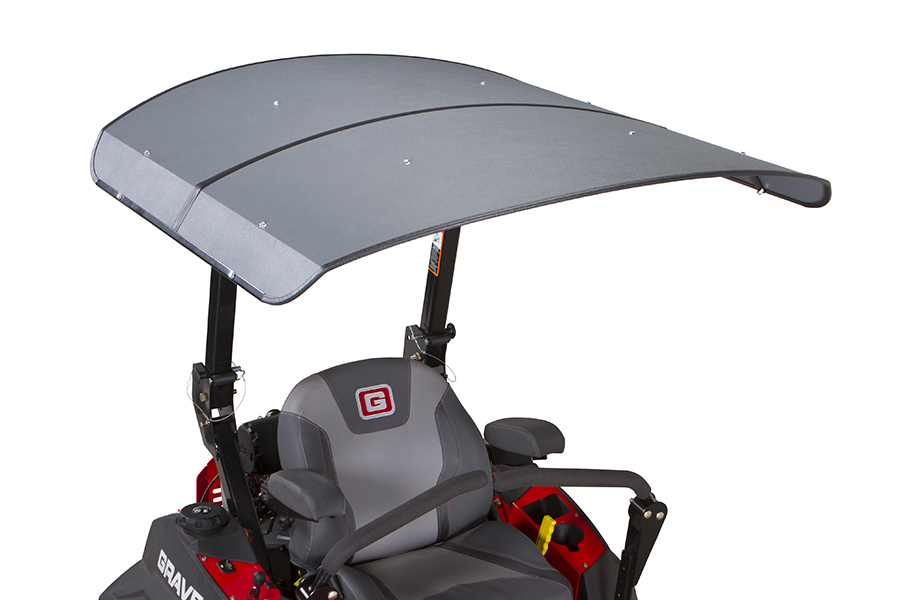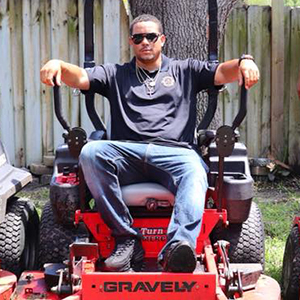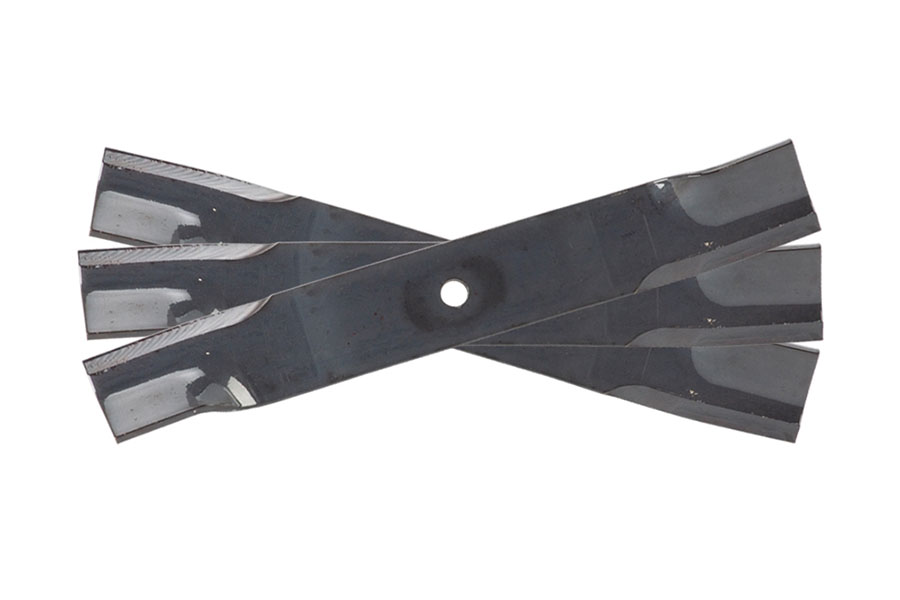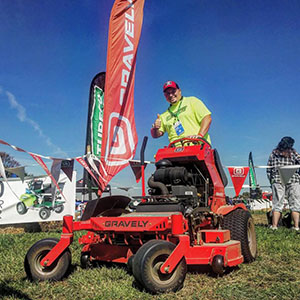Happy Holidays! Our Customer Support will be closed Dec. 24–26 for Christmas & Dec. 31–Jan. 2 for the New Year.
Working in Challenging Landscapes
How to cut grass in difficult conditions.
From the outside looking in, cutting grass and constructing flower beds might look easy, but step into the shoes of a commercial landscaper or lawn maintenance professional and you'll be surprised at the number of variables that make their jobs more physically demanding than deskwork. This industry takes place in the outdoors where uncontrolled climates and geography take control, leaving landscapers at the mercy of Mother Nature.
Though she's still in charge, there are several ways landscapers can get around her challenges. Read our tips to help tackle elevation, abrasive soils, weather and rough terrain on the job site.
Weather
Mother Nature is our landlord. She has all the power over the landscaping industry and controls the conditions contractors work in – hot, dry, wet, bright and dark. For warm-season grasses, hot temperatures may be good for lawns, but too much heat can put a strain on the professionals.
Mowing in high heat
Ambient temperatures are hot enough during the summer. Add humidity and the heat index can rise to levels that cause dizziness or even heatstroke – especially for landscapers wearing workwear covering most of their body. When working in high heat, the human body's natural response is to sweat, which cools the body when evaporated. However, sweating in these conditions causes fluid loss and requires frequent replenishment.
How much do we sweat?
According to active.com, the average person sweats between 27 and 47 ounces per hour during exercise. To put that into perspective, that's anywhere from one to two full, large water bottles. Though landscapers aren't jogging while cutting, it shows how much the human body can sweat and draws attention for the need to do replenish fluid loss.
Tips for working in heat
1. Hydrate
Those working outside need to hydrate often and fit in breaks throughout the day. To make up for the loss of sweat on the jobsite, the human body needs to consume enough water per hour to offset the loss in sweat, especially when the heat index climbs past 100 degrees. Those working outdoors need the most amount of water when working in direct sunlight, during peak energy exertion, and during the hottest part of the day.
2. Clothing for working outdoors
Avoid wearing clothing made of cotton. Cotton absorbs sweat and dries slowly, leaving you feeling wet and bogged down with heavy clothing. Instead, wear loose and breathable clothing made from materials like nylon or polyester. These materials help regulate body temperature and leave you feeling dry.
3. Shade yourself from the sun
Apply sunscreen throughout the day to prevent skin damage and get additional protection by wearing a brimmed hat and sunglasses. Or, ask your outdoor power equipment dealer if your lawn mower brand offers a sunshade kit accessory like the option Gravely offers for installation to several of its commercial lawn mower models.

4. Adjust your work activity
Adjust the work day to start earlier when it's still cooler and keep the heavy tasks loaded at the beginning of the day. Rotate physically demanding jobs tasks among workers that are acclimated to the heat, decrease the physical demands and pace of jobs and add extra personnel to physically demanding tasks, when necessary. Additionally, think about working at night. Yes, it comes with challenges, but Gravely helps make it possible by offering LED light kits that can be installed to any Gravely commercial lawn mower.
Gravely Ambassador tip on mowing in the heat:
"Proper protection from the sun is a must. Sun-protective clothing such as long sleeve shirts and large brim hats are just some of the items used to protect us from the sun. Staying hydrated is just as important so a cooler full of cold drinks keeps us going during the hot summer days."
-Marcus McCall, McCall’s Lawn Care, Florida

Mowing in the rain
In wet seasons like this one, you can try to wait the rain out, but sometimes it gets to that point where there's no way around it and you need to cut the grass, rain or shine. Wet grass is heavier, leaves a clumpy discharge, cuts poorly and makes the lawn mower engine work harder. Wet grass not only leads to more buildup underneath your mower deck, which disrupts your cut quality, but it leaves unsightly clumps that cover the lawn. If neglected, those clumps can block sunlight long enough and kill the grass it's covering.
If you have no choice but to mow wet grass, make sure your blades are sharp so you can minimize the tearing that can happen more easily in wet grass. Set your mower's cutting height to a higher setting and cut half rows to keep the cutting deck from trying to process too much grass, putting less strain on your deck, engine and preventing grass clipping overload that results in poor cutting performance and reduced efficiencies. Finally, always discharge wet grass clippings; never attempt to mulch or bag wet grass.
Gravely Ambassador tip on rain:
"In the Northwest, we are no strangers to the rain, and mowing in it is no easy task. While mowing in wet grass (mulching or side discharge) your mower will leave lawn droppings throughout the property. Taking a blower over the clumps will help with the mess and give you a cleaner appearance. For small properties, taking a blower over the lawn to knock the water off the blades will also help minimize clumping and deck build up."
-Jason Ambro, Ambro’s Landscaping Inc., Washington

If you can afford the time, take breaks with each lawn to stop the mower and safely clean debris out from under the mower deck. Removing grass buildup from the deck and the blades allows the deck's aerodynamics to work as designed and provide good cut quality. If you can't clean the deck during breaks on the jobsite, do it at the end of the day.
Soil
Why does soil matter when cutting grass? Grass is grass no matter what soil it grows from, but certain soils in the southernmost parts of the U.S have sandier soils. Aside from having little nutrient value and reduced ability to retain moisture and grow grass well, sandy soils can be problematic for professional landscapers and their equipment.
Problems with sand
When mowing sandy soils of Florida and southern Georgia, among other places, the airflow generated by mower decks kicks up the sand and circulates it around the mower blades and the deck, turning your zero turn mower into a sandblaster. The abrasive nature of sand, compared to clay or silt soils, wears mower blades fast. It's so bad for landscapers in these areas that they'll sharpen or replace blades weekly, costing them time and money.
What to do?
First and foremost, it's important for commercial cutters to check their blades daily. Even for those not mowing in highly concentrated sandy soil areas, certain soils can be surprisingly abrasive, causing blades to dull sooner than expected. When blades become dull and rounded, they cut less effectively and can lead to the need to double-cut, costing more time and money. If the issue is ignored completely and blades go without sharpening or replacement for too long, they tear grass instead of cutting blades cleanly, leaving grass stressed, discolored and more susceptible to disease.
The conventional approach to working in more abrasive soils would be to sharpen or replace blades more often, but this costs more downtime and money. To help avoid the hassle and the expense, landscapers can install LaserEdge® blades on their mowers.
The best lawn mower blades
Fisher Barton's LaserEdge blades debuted at the 2018 GIE+Expo in Louisville as a solution designed specifically for commercial landscapers working in sandy soil areas. LaserEdge blades use what's called EverSharp™ technology, which is a reinforced bottom layer on the cutting edges of the blade that wears at a slower rate than conventional blade material. As the top layer (conventional material) wears away, the bottom layer remains, creating a new cutting edge. These self-sharpening blades are so effective that they've been tested and proved to last for up to 50 hours, which is nearly five times longer than conventional blades in the harshest cutting conditions.

To see how LaserEdge blades can save time and money, ask for them from your local Gravely dealer or click here to purchase them online.
Terrain
Mowing on rough terrain
Mowing rough terrain has enough bumps and jolts to give the operator fatigue and in the more severe cases, can lead to back pain. Excessive vibration can also be uncomfortable.
Features designed for working on rough terrain and handle vibration are already built into commercial Gravely zero turn mowers. Plush seats, air ride seats, suspension seats, seat isolators and steering lever grips are standard on certain commercial zero turn mowers to help minimize shock and vibration, reduce operator fatigue keep operators comfortable. Additionally, landscapers have the option to purchase foot mat kits for certain zero turn models to help minimize vibration at the operator's feet.
Mowing on uneven terrain
Landscapes come in all varieties. Some flat and even, others steep and hilly, which makes it difficult to maneuver around for mowers that weren't designed for those applications. Gravely commercial zero turn lawn mowers, stand on mowers and walk behind mowers are designed for safe operation on inclines no greater than 15 degrees, 10 degrees and 20 degrees, respectively, but there are some things you want to consider when talking hills and slopes:
- Install a rollover protection structure (ROPS) to your zero turn mower, if not already equipped. When used correctly, this can help protect the operator in the event of a rollover on steep landscapes.
- Use self-propelled push mowers to mow slopes.
- Mow up and down instead of side to side.
- Maneuver slowly on steep slopes and choose ground speed so you don't have to stop or shift while on a slope. Keep all movement on slopes slow and gradual.
- Keep the brakes and transmissions properly adjusted and maintained.
- Never mow on wet or damp grass because the tires may lose traction.
Gravely Ambassador tip on terrain:
"Make sure you have the right equipment for the job! Don't use equipment not recommended for steep inclines to tackle those jobs. Sometimes it's better to slow down, grab a walk behind mower and get the job done that way."
-Andy Wilson, Cut & Clean Lawn Care, Missouri

Elevation
Internal combustion engines can have issues working in high elevations, like in Appalachia or the Rocky Mountains. Why? Because air is thinner at high elevations, making it more difficult for a naturally aspirating engine to breathe and get the required amount of oxygen for combustion to occur and initiate the power stroke.

Small engine side note: Four-stroke engines, which are just about 100% of the engines in today's lawn mower and snow blower market, have four cycles: intake, compression, power and exhaust. Intake pulls gasoline and oxygen into the combustion chamber where they're pushed together in the compression stroke and ignited by a spark plug, which creates an explosion and generates power. Without oxygen, combustion is choked, the power stroke doesn't occur, and your engine sits idle.
What's a naturally aspirating engine?
While not all four-stroke engines (those described above) are not naturally aspirating, all carbureted engines equipped on Gravely lawn mowers are. Naturally aspirated, or "naturally breathing" means that the oxygen intake of an engine is unassisted and controlled entirely by atmospheric pressure, which changes at varying altitudes. So, unless your carbureted lawn mower engine is equipped with a turbocharger or supercharger, which we're betting it isn't, your engine's oxygen intake is entirely dependent on the oxygen content of your environment.
Science of air density
Air density decreases in areas of higher elevation, meaning atoms of the gases in Earth's atmosphere (oxygen, nitrogen, hydrogen, etc.) also decrease. In fact, air density decreases by one-third with every 10,000-foot climb above sea level, meaning the ability for an engine to breathe and have combustion in Denver (5,280 feet above sea level) will be harder than lawn mower engines in New Orleans, elevation: one foot above sea level.
Think of engines like humans. As a mountain climber ascends Mount Everest, they breathe harder to compensate for the reduced amounts of oxygen pulled in with each breath. Engines operate the same way. Engines compensate by using more fuel to work harder, making them less efficient and causing the engine to run rich (use too much fuel) – bogging the engine down, causing it to stall or even causing it to fail to start in high elevations.
Engines for high elevations
The solution for those working in high elevations is simple: ditch the combustion engine for an EFI (electronic fuel injection) option. Unlike naturally aspirating engines, EFI engines use an ECU, or engine control unit, which is like the brain that controls the air-to-fuel mixture needed for combustion. This brain knows the atmospheric pressure and draws in the required amount of air to make the engine operate as efficiently as possible with consistent power and better fuel economy at varying altitudes with varying oxygen densities.
Click here to explore the Gravely lineup and see which commercial mowers come equipped with EFI options.
